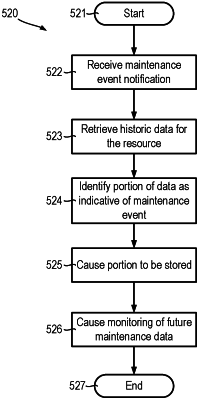| CPC G05B 23/0283 (2013.01) [G05B 23/0237 (2013.01); G06F 11/0766 (2013.01); G06F 11/3003 (2013.01); G06F 11/3089 (2013.01); G06F 11/3476 (2013.01); G06F 16/219 (2019.01); G06Q 10/06 (2013.01); G06Q 10/20 (2013.01)] | 19 Claims |

|
1. A computer-implemented method of predicting maintenance events with respect to resources, the method being performed by one or more processors or special-purpose computing hardware, the method comprising:
receiving a notification of a maintenance event associated with the diagnosing of a fault of a first resource;
retrieving, in response to receiving the notification, historic maintenance data in relation to the first resource with which the fault is associated, the historic maintenance data originating from a time period preceding a time of the maintenance event, the historic maintenance data indicating a relationship between a first parameter obtained from a first sensor and a second parameter obtained by a second sensor, wherein the historic maintenance data includes a first parameter curve of the first parameter, a second parameter curve of the first parameter, and a third parameter curve of the second parameter, the first parameter curve and the third parameter curve having a first common time scale, and the second parameter curve having a different time scale;
identifying a subset of the retrieved historic maintenance data as being indicative of the maintenance event;
storing the subset as one or more precursor signals of the maintenance event; and
monitoring subsequent maintenance data from the first resource or a second resource to predict, based on the one or more precursor signals of the maintenance event associated with the fault of the first resource, a subsequent occurrence of the maintenance event in the first resource or the second resource.
|